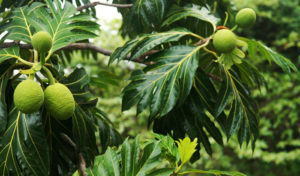
Accra, Ghana, April 26, 2019//-Breadfruit in the time past grew wild in many parts of Ghana. Its fruits were left to rot in the forest as few people took notice of them.
Now under the government’s policy of diversification of export crops the neglected breadfruit is being brought back – farmers are being trained in the proper management of the crop and given seedlings to cultivate.
Research in Ghana shows that replacing wheat flour with 20 percent non-wheat flour for the manufacture of bakery products would result not only in an estimated savings of US$2 billion annually to Ghana but also create thousands of jobs for Ghanaians.
According to nutritionists, the breadfruit is an excellent source of carbohydrates, and is eaten mostly roasted, boiled or fried.
Recently, other recipes have been developed such as pies, pudding, punch, chips, fritters, and the male inflorescence made into a confectionery.
The leaves are sometimes boiled to make a drink which is regarded as useful for relieving symptoms of heart diseases and high blood pressure.
It is also used as animal feed especially during droughts. The wood which has an attractive colour is used to make furniture, and the sap is sometimes used as glue. The plant also provides good shade for crops such as cocoa and coffee and is a beautiful ornamental.
The breadfruit is a superior tree for reforestation work. It grows quickly and the forest ground cover can grow and diversify under its canopy.
The timber is a sturdy, dense, water resistant softwood used by Pacific Islanders for their ocean-going sailing canoes of 12 metres and more with which they conquered the Pacific one, two, three thousand years ago and more. They can be directed to household or commercial use.
The world’s top “tree vegetable” is breadfruit which is in many ways more like rice, wheat or, especially, potatoes, yam and cassava than a fruit and is easily processed into bread flour and turned to many other uses associated with starchy staples – from nutritious baby food to snack foods similar to potato crisps and chips.
Historically the breadfruit is native to New Guinea but has been widely distributed to many tropical regions, especially the Pacific islands. There are hundreds of varieties, each with attributes preferred in certain regions. The plant is suited for areas where temperatures of at least 60 degrees Fahrenheit (16 C.) occur but fruits best where at least 70 degrees F. (21 C.).
Experts say most breadfruit issues start when plants are young and are related to incorrect cultural care. If soil is poor, the root system will not develop properly, limiting the plant’s ability to gather water and nutrients as well as support itself.
Young plants that dry out may die and need to be monitored daily to prevent such losses. The plants need to be installed in the ground in holes at least 15 inches (40 cm.) deep and 3 feet (0.9 cm.) wide. Spacing is very important to prevent fungal diseases.
Trees should be at least 25 feet (7.5 m) apart. Pruning after the tree is 4 years old to develop a strong leader and well-spaced branches is recommended but not necessary in some varieties.
Breadfruits are picked when maturity is indicated by the appearance of small drops of latex on the surface. Harvesters climb the trees and break the fruit stalk with a forked stick so that the fruit will fall.
Even though this may cause some bruising or splitting, it is considered better than catching the fruits by hand because the broken pedicel leaks much latex. All parts of the tree, including the unripe fruit, are rich in milky, gummy latex.
There are two main fruit types: the normal, ‘wild’ type (cultivated in some areas) with seeds and little pulp, and the ‘cultivated’ (more widely grown) seedless type, but occasionally a few fully developed seeds are found in usually seedless cultivars. They are packed in cartons in which they are separated individually by dividers.
An important plus for the crop is that whether for household consumption or food processing factories, one can harvest for carbohydrate content at any early-mid to late maturation point during a fruit’s growth.
This is well since factories may specify an optimal size for mechanical processing for each variety. Grove owners will harvest, one might imagine, a size of fruit just smaller than that at which they most often fall from their own weight while the trees crop fairly well continuously through the two varieties’ peak seasons of the two main Samoan varieties presently involved.
Farmers with small plantings will learn the required dimensions and have a new cash crop when times are good and a resource for their families and the community beyond, even when drought is severe enough to devastate all other crops.
The market is wide, the prospects are good but it will be great if the government can get more involved and put good structures in place.
By Oppong Baah, African Eye Report


